This easy pesto pasta recipe is simple, but so full of flavor! Make the pesto while the pasta cooks, and dinner is ready in less than 30 minutes!
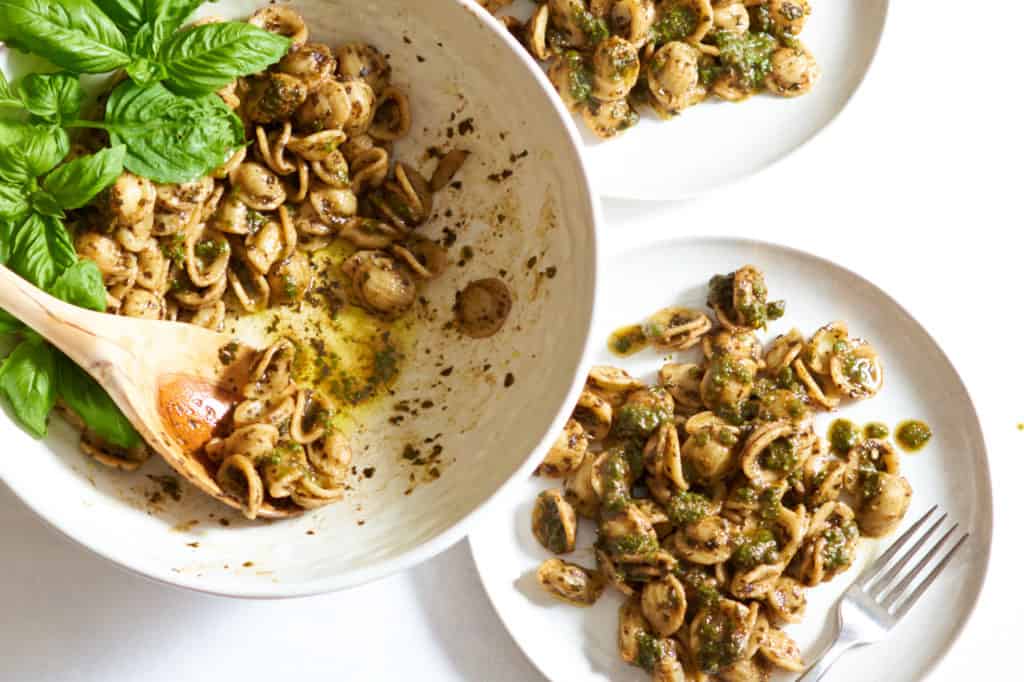
This post contains affiliate links. If you purchase through my links, I may make a small commission at no additional cost to you. As an Amazon Associate, I earn from qualifying purchases. Read my full disclosure policy here.
What could be better at the height of summer than a bowl full of pesto pasta? Peak basil amazingness, simplicity at its finest, and everyone loves it.
You may be tempted to buy a jar of store-bought, but please don't! Homemade basil pesto is so easy to make, then all you have to do is boil the water for the pasta!
With just a few ingredients, you can make an incredibly flavorful pesto pasta recipe that's ready in about half an hour. Because summer meals shouldn't be complicated and time consuming.
Jump to:
- Ingredients you'll need
- Recommended tools and equipment
- How to make pesto pasta
- Expert tips and tricks
- Frequently asked questions
- Storage and reheating instructions
- Pesto pasta add-ins
- Pesto variations
- Best pasta shapes for pesto
- What to serve with this recipe
- More recipes with pesto
- This easy pesto pasta recipe is simple, quick and customizable!
- Recipe
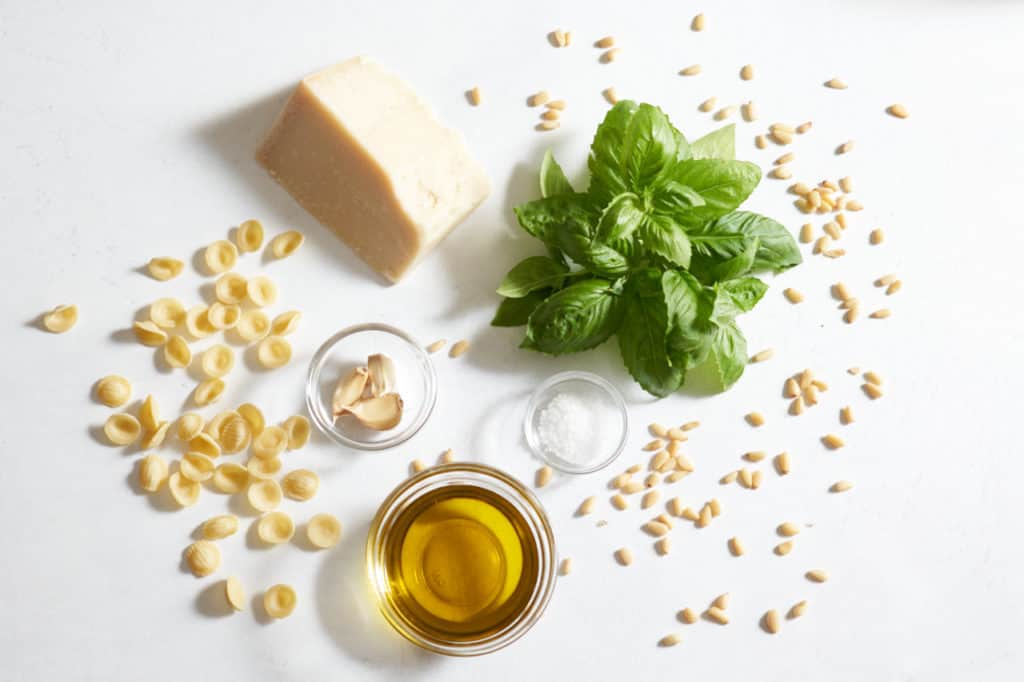
Ingredients you'll need
My pesto pasta recipe only has 7 ingredients including the pantry staples! It's quick and easy, perfect for a lazy summer dinner or weeknight meal.
- Pasta: There are several shapes you can choose, from fusilli to orecchiette. Just make sure you choose a quality pasta noodle. Hint: the pasta should have a nice yellow color to it, which lets you know that good eggs and good semolina were used to make it. I like DeCecco, which you can readily find online and at many grocery stores.
- Basil: Fresh basil from the garden or a farmer's market is best. (Try growing some! It's easy!) Don't buy basil that is starting to turn brown or black in spots or around the edges. Never store fresh basil in the fridge.
- Parmesan cheese: Use real parmigiano reggiano cheese. It makes all the difference in the world and very much worth the price. We only have a few ingredients, so use high quality ones and let them shine.
- Pine nuts: These will add creaminess and a nutty complement to the parmesan. They can be expensive, so walnuts make a good substitute.
- Olive oil: Choose a high-quality, mild olive oil that's not too peppery so it won't overpower the basil.
- Garlic and salt: Not too much garlic, since it will be going in raw, and not too much salt, since the parmesan is already salty.
Traditionally in Italy's Liguria region, pesto is served with trofie, a thin, twisted pasta. But that can be hard to find in other places. You want pesto to get into nooks and crannies, so choose a pasta shape that will allow that sort of thing to happen!
Recommended tools and equipment
- Food processor: To make the pesto.
- Large stock pot: To boil the pasta.
- Medium skillet: For toasting the pine nuts.
- Box grater: To grate the parmesan cheese. I always prefer to grate my own cheese, as pre-grated can dry out.
- Colander or spider tool: To drain and transfer the pasta.
How to make pesto pasta
Step 1: Start cooking the pasta
Bring water to boil in large stockpot. Once boiling, season with salt so it 'tastes like the sea'. Then add the pasta noodles. Cook until al dente according to package instructions.
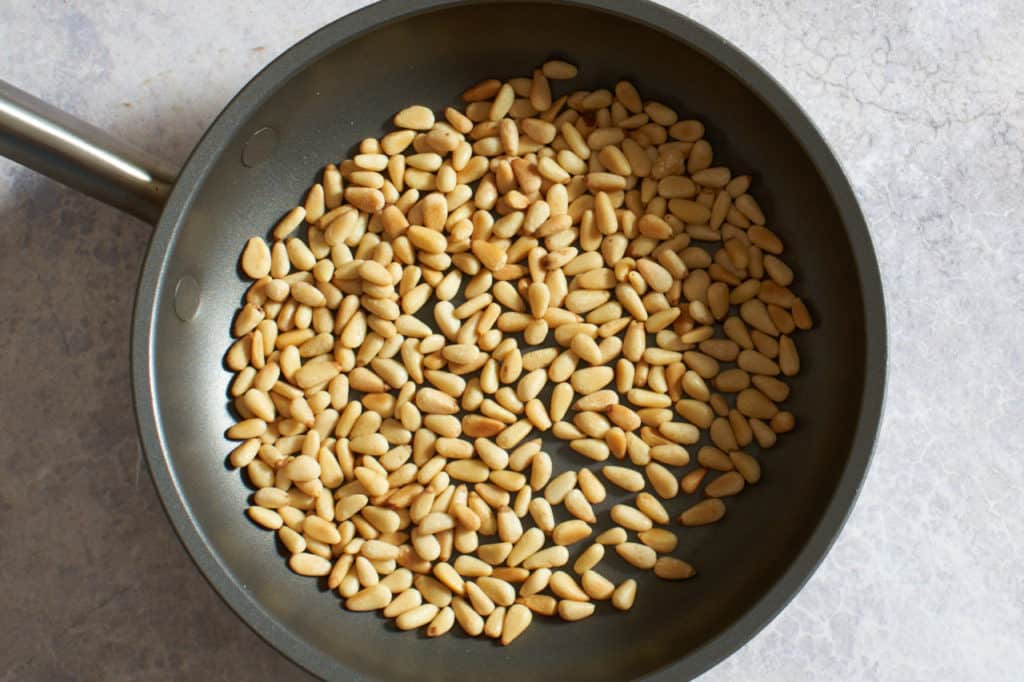
Step 2: Toast the pine nuts and grate the cheese
Meanwhile, in a dry skillet, toast the pine nuts over medium heat until they are lightly golden. Set aside to cool.
Grate the parmesan cheese on a box grater.
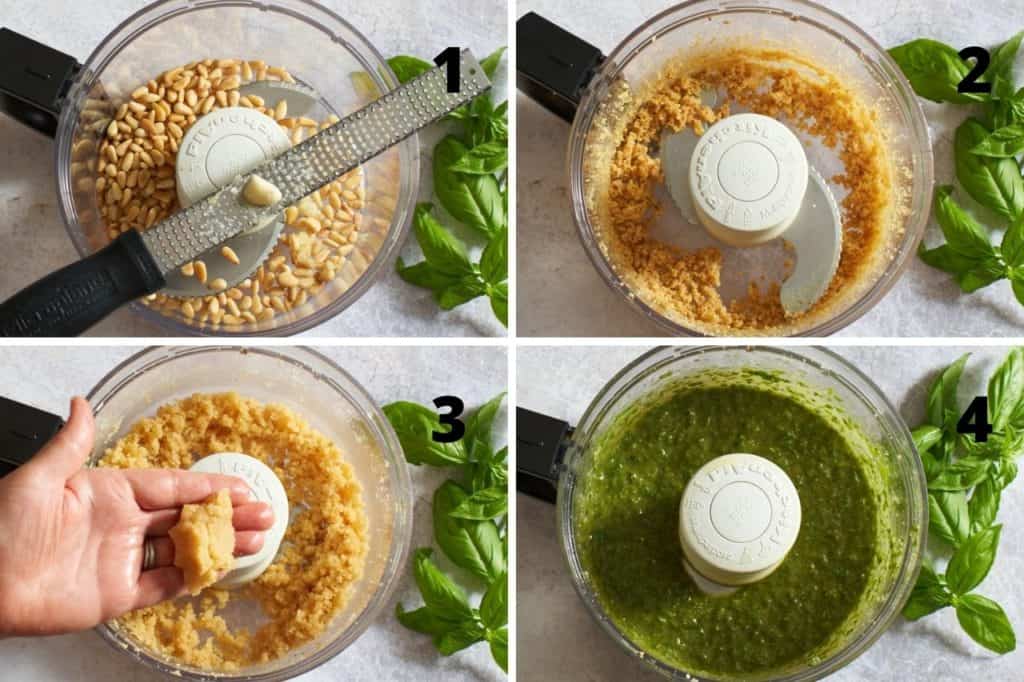
Step 3: Make the pesto
This pesto recipe is genius because it is made entirely in a food processor, yet has the smoother texture of the mortar and pestle method. It's adapted from Bon Appétit.
Put the cooled pine nuts in a food processor. Use a microplane grater to grate the garlic and add to the pine nuts.
Process the pine nuts until they are very finely ground.
Add the parmigiano cheese and process until the mixture is clumping together. You should be able to squeeze it into a ball with your hands like dough.
Want to save this recipe?
You'll join hundreds of readers on my email list!
Add the basil and salt to the food processor and put the lid back on. With the motor running, pour the olive oil slowly into the basil mixture until the basil leaves are finely chopped and the mixture is smooth, up to 1 minute.
Scoop about half of the pesto into a large serving bowl. Reserve about ½ cup of pasta water.
Drain the pasta, or use a spider or slotted spoon to scoop it from the pot, then place it into the bowl on top of the pesto and stir to combine. Add more pesto if necessary and serve immediately.
Prep Tip You want some of that starchy pasta water still clinging to the noodles so the pesto will stick to it! Don't let your pasta get too dry.

Expert tips and tricks
- Don't over-process the pesto. The heat from the blades can darken the basil leaves, so as soon as you reach a smooth texture, STOP!
- Never heat pesto before serving! You'll ruin it! If you have it stored in the fridge, allow it to come to room temperature before using. The heat from the pasta will activate the flavors and melt the cheese so the sauce will stick to the noodles.
- Be sure to salt the pasta water! This is an essential step. It's the difference between a bland, boring dish and heavenly, delightful pasta.
- Don't overcook the pasta. It should be al dente, which means it should have a bit of chew to it. Don't let it turn to mush. Proper texture is one of the things that makes eating pasta so satisfying!
Frequently asked questions
Yes, store-bought pesto works just fine for this pasta recipe. After all, we are trying to make things easy!
Some of the ingredients in pesto are a good source of antioxidants but are also high in fat. Tomato sauce can be lower in calories and is a good source of potassium and vitamin C. Because everyone's health needs are different, ultimately what is healthy for you should be determined in conversation with your doctor.
Yes! Pesto pasta makes and excellent cold dish or pasta salad. Add the pasta to the pesto sauce while still warm so it can absorb the flavors, then chill in the refrigerator. Let it stand about 10 minutes before serving so the sauce can loosen up.
No! Don't heat the pesto first. The warmth of the pasta noodles will be enough. When pesto is heated the basil changes to a darker color and the cheese will melt, and we don't want that.
Storage and reheating instructions
To store leftover pesto sauce, place it in an airtight container with some olive oil drizzled over the top to cover it. This layer of olive oil will keep it from turning a dark color underneath.
If you have leftover pesto pasta, store in the refrigerator in an airtight container. I don't recommend reheating it, as it will change the color of the basil and texture of the sauce. Enjoy it cold as a pasta salad!
Pesto pasta add-ins
Try these easy ideas when you want to zhuzh up your basil pesto pasta with some additional ingredients.
- Fresh cherry tomatoes are great in the summer time.
- Sun dried tomatoes would be a great fit all year long.
- Rotisserie chicken or cooked shrimp.
- Cooked spinach. (Be sure to squeeze out the moisture.)
- Peas! Peas and pesto really do love each other.
- Cannelini beans or chickpeas.
Pesto variations
Who says you have to make your pasta with basil pesto? Try these easy variations on traditional pesto for your next pasta meal!
- Basil not in season? Make this pasta with Sage Pesto instead!
- I love to make Kale Pesto all year round! It's a great way to get some extra veggies in your pasta.
Best pasta shapes for pesto
- Trofie
- Orecchiette
- Fusilli
- Farfalle (bow-tie pasta)
- Cavatappi
What to serve with this recipe
Start with a Massaged Kale Salad, or summery choices like a Nectarine Salad with Tomatoes and Herbs, or a Strawberry Arugula Salad with Basil and Mint. End the meal with Mixed Berry Cake, a Plum Upside Down Cake, or the Italian classic, Coffee Granita!
More recipes with pesto
Basil pesto is such a versatile ingredient! Here are some more ways to use this taste of summer while the sun shines.
- Of course you can use the pesto in other ways, how about Gnocchi with Peas and Pesto?
- Pesto Potato Salad is a light, summery twist on the classic version.
This easy pesto pasta recipe is simple, quick and customizable!
- Only 7 ingredients!
- The basil pesto comes together quickly in the food processor.
- Easy prep: Just toast the pine nuts and grate the cheese.
- Ready in under 30 minutes!
- Use different kinds of pesto, swap pasta shapes, and endless ideas for add-ins!
Recipe
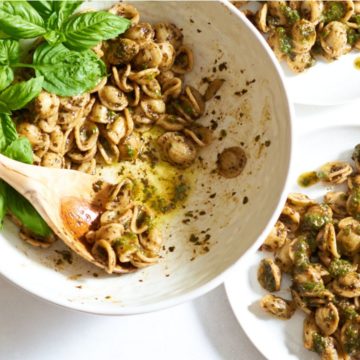
Easy Pesto Pasta
Ingredients
- 1 pound pasta such as orecchiette or fusilli
- 6 cups fresh basil
- 1 cup extra virgin olive oil
- 2 ounces parmesan cheese
- ½ cup pine nuts
- 2 cloves garlic
- 1 teaspoon kosher salt plus more for the pasta water
Instructions
- Bring water to boil in large stockpot. Once boiling, season with salt so it 'tastes like the sea'. Then add the pasta noodles. Cook until al dente according to package instructions.
- Meanwhile, in a dry skillet, toast the pine nuts over medium heat until they are lightly golden. Set aside to cool.
- Grate the parmesan cheese on a box grater.
- Put the cooled pine nuts in a food processor. Use a microplane grater to grate the garlic and add to the pine nuts. Process the pine nuts until they are very finely ground.
- Add the parmigiano cheese and process until the mixture is clumping together. You should be able to squeeze it into a ball with your hands like dough.
- Add the basil and salt to the food processor and put the lid back on. With the motor running, pour the olive oil slowly into the basil mixture until the basil leaves are finely chopped and the mixture is smooth, up to 1 minute.
- Scoop about half of the pesto into a large serving bowl. Drain the pasta, then place it into the bowl with the pesto and stir to combine. Add more pesto if necessary and serve immediately.
Want to save this recipe?
You'll join hundreds of readers on my email list!
Notes
- Don't over-process the pesto. The heat from the blades can darken the basil leaves, so as soon as you reach a smooth texture, STOP!
- Never heat pesto before serving! You'll ruin it! If you have it stored in the fridge, allow it to come to room temperature before using. The heat from the pasta will activate the flavors and melt the cheese so the sauce will stick to the noodles.
- Be sure to salt the pasta water! This is an essential step. It's the difference between a bland, boring dish and heavenly, delightful pasta.
- Don't overcook the pasta. It should be al dente, which means it should have a bit of chew to it. Don't let it turn to mush. Proper texture is one of the things that makes eating pasta so satisfying!
- To store leftover pesto, place it in an airtight container with some olive oil drizzled over the top to cover it. This layer of olive oil will keep it from turning a dark color underneath.
Nutrition
Nutrition information is automatically calculated as an estimate. Calorie accuracy is not guaranteed.

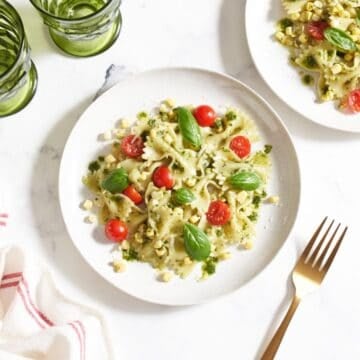
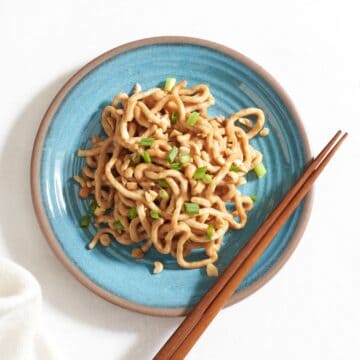
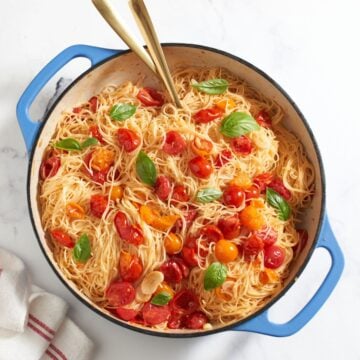
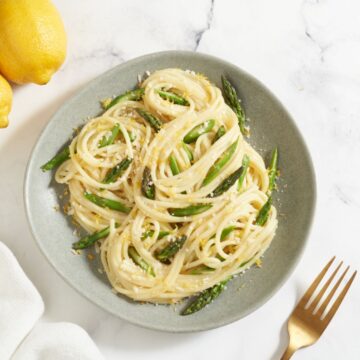
Linda Cummings says
Yummy and simple.